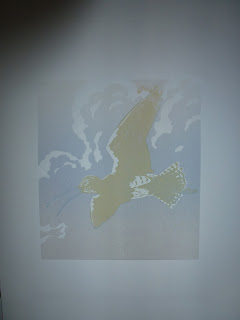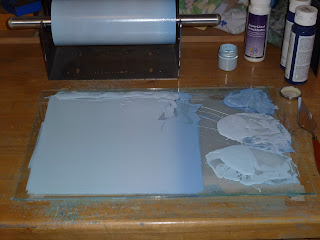Following on from a recent small print I made of a Brown Trout rising to take a fly. Which, when I posted it on the excellent Linocut Friends facebook page, created quite a lot of interest in how it had been made. I promised to do another and show all the step by step stages. So here it is:
This is my working drawing with all the elements drawn out and the pattern of ripples determined. Like any representational image the basic problem is to give the illusion of depth. Although unlike a landscape, where you only really have to be concerned with the depth from the foreground to the horizon. With this print I want to give the illusion of not only the water surface going away from the viewer, but also the depth of water below the surface and then getting deeper as the river bed drops away beyond the fish.
Step 1.
There is only one spot of pure white in this print, where the fish just breaks the surface of the water. So a small piece of lino is cut out and the block inked up in a pale yellow colour and printed as below.
Step 2.
Some more small marks are made in the lino to represent small paler pebbles on the river bed. At this stage because the initial colours are pale and I don't want to risk the drawing offsetting on to the print. I am only drawing on to the block the areas that I am removing. Once all the marks that I want have been cut away I ink up in a pale blue.
and print as below.
Step 3.
The pale blue represents the paler ripples moving across the water surface. So these are now cut away from the block and the shape of the fish drawn on.
I mix up three colours, a pale yellowish grey, an orange and a pale purplish grey and using a brush carefully paint the ink onto the block to give me the basic body colour of the fish.
Although this stage is essentially a monoprint, with care it is possible to get a consistent result across the edition of 10 prints.
Step 4.
With the body colour of the fish defined I cut out a lot of the paler areas from its body leaving just the darker bits on its upper surface. I mix up a blend of yellow through orange and brown to a slightly darker blue than that used previously. This is going to put down the base colour for the river bed, some details on the fish's body and finish off the water surface in one go. (The size of the image at 240mm high was determined by the size of my largest roller, as I need this blended roll to cover the whole block in one go).
From now on it's just a matter of gradually darkening the oranges and browns to complete the details in the print.
Step 5.
After cutting out some pebble shapes a three colour blend of copper through brown to blue grey is rolled on the block and printed.
And the print starts to emerge.
Step 6.
More cutting away of pebble shapes and spots on the fish's body and the block is inked with a dark purple grey colour. This was intended to be the final colour but looking at the print I wasn't happy with abrubt end to the pebbles. I wanted to give the impression of them fading out of view into the deeper water but this colour has made them too dark in contrast to the water colour.
Step 7.
As a fix, I mix up a blend of a dark purple grey fading to pale blue and ink up the block again.
and the final print.




























































